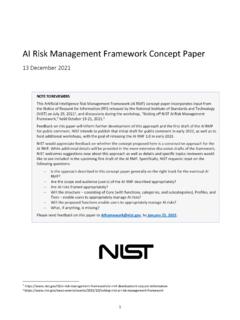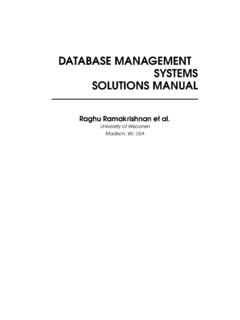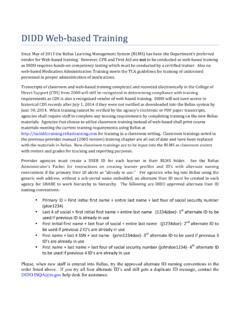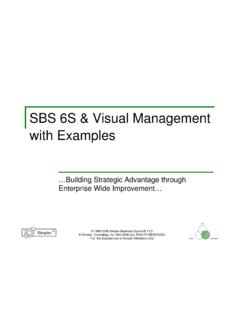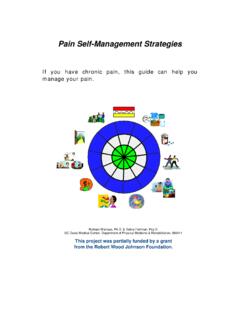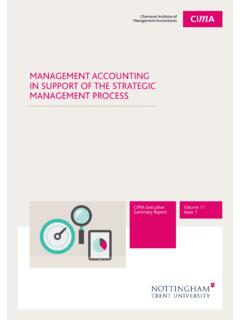Transcription of Next Generation Vendor Management - Deloitte
1 Next Generation Vendor Management 03 Brochure / report title goes here | Section title goes here Executive Summary 04 Introduction 05 Outsourcing Trends 06 Vendor Management Challenges 07 Case Studies 08 Next Generation Vendor Management Solution 1004 Executive SummaryToday, outsourcing is increasingly used by companies as an enabler for innovation. Technological advancements drive improvements in service delivery, which has not only a positive impact on cost but also enhance functionality, increase service quality and reduce the importance of location on service delivery. Disruptive technologies like cloud computing enable solutions such as or ServiceNow to accelerate speed to value and drive business growth. This leads to a change from the traditional IT organization to the next Generation IT organization. More agility in the operating model is required to respond faster and at different speeds to new service offerings. Outsourcing models have reached the third Generation and involve a multi- Vendor environment requiring more transparency and integrated Vendor realize the potential outsourcing benefits, Vendor Management Organizations (VMO) have to adapt to new Generation outsourcing models and are challenged to integrate multiple vendors and enable supplier collaboration.
2 Complexity is increasing and governance improvements are inevitable, to manage such diverse Vendor relationships and to measure service delivery reliably. The survey shows that Vendor Management Organizations are not yet fully equipped to handle these challenges. We recommend to establish a common platform that integrates all asset and service providers, business users, procurement and Management as an integrated ecosystem to achieve high Vendor Management effectiveness. Deloitte s Vendor Management suite is a single platform that provides the required capabilities to manage complex supplier ecosystems, monitor Vendor performance and leverage Vendor capabilities in order to drive innovation, cost savings, and efficiency gains. 2 Deloitte : Deloitte s 2016 Global Outsourcing SurveyIn our global outsourcing survey 2016 half of the respondents stated that they use only a maximum of 40 percent of the outsourcing potential today. 2 Next Generation Vendor Management | Executive Summary05 Next Generation Vendor Management | IntroductionIntroductionOutsourcing today Worldwide outsourcing has continued to our global outsourcing survey 2016 half of the respondents stated that they use only a maximum of 40% of the outsourcing possibilities Companies are expecting ongoing innovation from their managed service providers, especially since the benefits of using a global workforce and process improvements have largely been achieved.
3 Today, outsourcing orientates services into models that fully support business processes. These services are increasingly cloud based and offered by not only a few but many different service providers. The sourcing model has moved away from a siloed approach to a multi- Vendor environment. The high diversity in the sourcing portfolio has increased complexity and Vendor Management Organizations are challenged to manage and control Vendor relationships in an efficient way to ensure seamless service delivery across service potentialCurrently IT is the area with the highest degree of outsourcing, respondents stated that they expect to increase outsourcing of all other functions. IT leaders responded that they intent to increase their use of outsourcing by more than 30 percent for various business There is a significant potential to leverage outsourcing horizontally for functions that are so far provide in-house, especially Finance and Human Resources.
4 Furthermore, companies use outsourcing as enabler of innovation and leverage outsourcing partners as change and transformation catalysts. 35 percent of clients are already measuring the value of innovation in outsourcing based service deliveryOutsourced services are increasingly realized by vendors based on cloud technologies. The cloud brings a security hurdle, influences application models and changes the role of the IT organization in business decisions. Companies are challenged to establish mechanisms to handle security and control complexity. Furthermore, cloud services have different formats depending on the service provider and the service type. Today, a reliable measurement of these services is more difficult when the number of different service types and vendors ManagementVendor Management Organizations (VMO) have to adapt to the new Generation outsourcing models. Complexity increases with multiple suppliers, and governance is required to manage and monitor a diverse supplier ecosystem as illustrated Figure 1.
5 The inhomogeneity of the sourcing portfolio increases as vendors cover an increasingly wide range of services. Cur-rently the existing Vendor Management capabilities and tools are not yet enough to ensure full transparency or to efficiently manage the multi- Vendor relationships in order to realize the value available from outsourcing. 2 Deloitte : Deloitte s 2016 Global Outsourcing SurveyFigure 1: Multi- Vendor IntegrationService Provider (SaaS, PaaS)IT Service ProviderBusiness Process ProviderAsset Provicer (Hardware, Software)Next Generation Vendor Management | Outsourcing Trends06 Outsourcing continues to create new opportunities for service providers and clients. According to the respondents there is still a large potential with outsourcing. Technology advancements accelerate speed to value, reduce implementation times and enhance functionality. Multiple vendors are integrated into one service orientated mo-del. The outsourcing landscape is changing.
6 The next Generation outsourcing model Outsourcing is evolving as illus-trated in Figure 2. This model is a converged and integrated multi- Vendor ecosystem. Sourcing partner as innovation catalystMore and more organizations see top line growth by driving innovation into the business itself. In our survey 35 percent of respondents are already focused on meas-uring the value of innovation in their out-sourcing relationships. Innovation creates competitiveness advantage and ensures continuous improvements. Measuring and quantifying innovation is an important and challenging task of Vendor Management Organizations. New mechanisms and indi-cators are necessary to measure the value innovation contributes to multi- Vendor relationships and supplier ecosystemsThe increasing number of different suppliers engaged raise Vendor diversity. The traditional sourcing model transforms to a multiple- Vendor environment. A supplier ecosystem emerges with key requirements on integration and collaboration of vendors and business functions.
7 New capabilities are necessary to oversee the complexity and to provide an enterprise-wide view on the multi- Vendor model. Vendor Management Organizations need to manage relationships and align client and vendors objectives to ensure orchestrated service delivery and sustainable Vendor servicesCloud computing has continued to evolve and the acceptance and adoption of cloud based solutions have increased. Organizations are increasingly connecting cloud-to-cloud or cloud-to-core systems to realize their business processes. This influences the IT organization and changes the traditional outsourcing model to a cloud-based outsourcing model. Cloud services have new formats and different types of vendors emerge. The Vendor Management function needs to be equipped with capabilities to control and manage these different provider types and to install monitoring mechanisms to ensure service availability, accuracy and continuity. ConcernsConcerns about outsourcing decreased in 2016.
8 However, the majority of respondents still feel that data privacy requirements might lead them to redesign their use of outsourcing. As in the last few years, communication problems were stated as major concern. Security risks are now considerably affecting outsourcing decisions. Lack of due diligence, criminal actions or breaking security standards are the risks clients see with outsourcing, especially related to countries with high volatility and low quality infrastructure. Outsourcing TrendsHow is the outsourcing market evolving? Single Vendor 1000 Pager Focus on The Deal Labor Arbitrage Niche AdvisoryOutsourcing - The Mega Deal1990 s to 2005 Post 2005 Outsourcing - Strategic Sourcing Multi- Vendor Governance & Vendor Management Focus on Provider s Ability to Transform Existing ProcessesEmergingOutsourcing - Convergence Innovation and Transformation Enabler Integrated Multi- Vendor Model Customer Orientated Service Model Cloud Based Service Delivery AutomationSmart Sourcing FocusFigure 2: Outsourcing - Future, convergence outsourcing model07 Complexity and cost of managing multiple service providersThe multi- Vendor environment today brings complexity and new challenges to companies.
9 Vendor Management Organizations not only have the responsibility to manage all vendors on an operational level but oversee the entire ecosystem to ensure vendors are collaborating towards the same objective. This becomes very time consuming and costly in order to achieve the defined service levels. New capabilities and tools are required to manage multiple service providers in an efficient way and to ensure an end-to-end of client and Vendor objectives to ensure sustainable relationshipsThe alignment of goals and the collaboration between vendors is getting more and more important to drive collective success and to ensure a sustainable relationship. This is only possible if vendors and clients have a common understanding of the operational and overall strategy so that everyone is moving in the right direction. Both parties in the client- Vendor relationship need to proactively share relevant information. This requires a common platform as single source of truth to be able to share what is relevant to client and Vendor .
10 VMOs are responsible to create an environment of trust so that all parties can exchange infor-mation on a continuous basis. This ensures effective communication and sustainable relationships. Bringing together diverse vendors in a fragmented environmentAs outsourcing is increasingly used for different areas, service providers have to be integrated across multiple functions. Bring-ing all these vendors together into a single, unified environment is a challenging task for Vendor Management Organizations. To ensure a harmonized environment a standardized approach is required. Differ-ent vendors and services types have to be integrated. A common platform becomes inevitable to build a single source of truth for all service providers to ensure conver-gence and end-to-end service integration. Limited view of Vendor performance due to the lack of monitoring mechanismsIn multi- Vendor environments, achieving transparency across all vendors is a key challenge.












